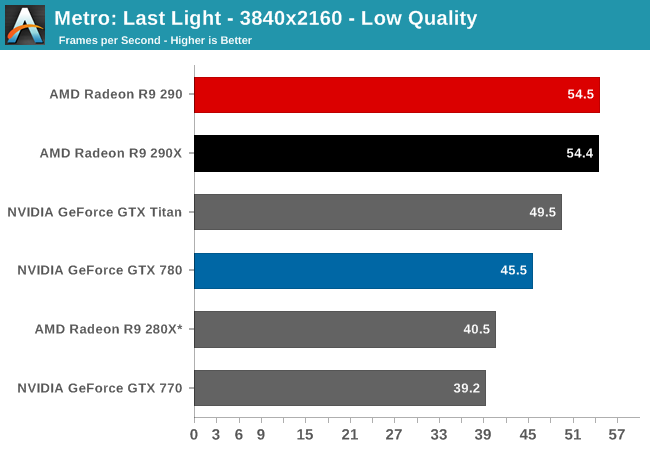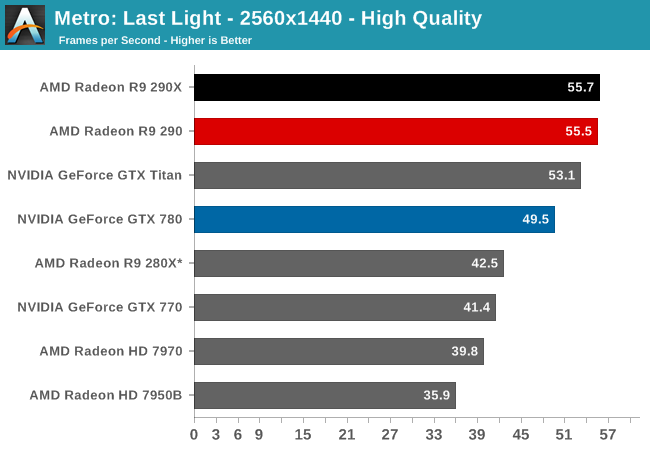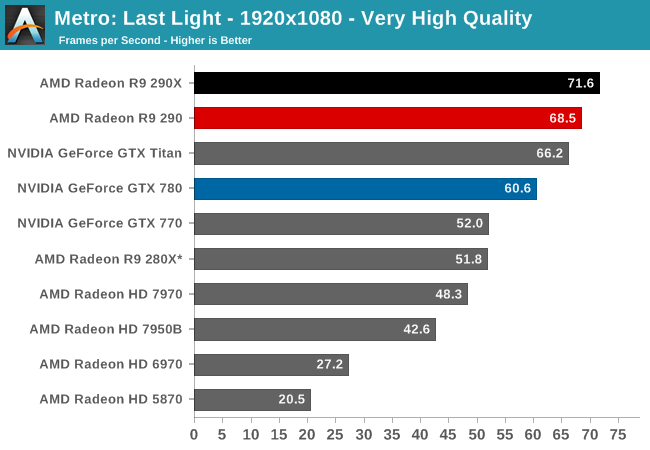The AMD Radeon R9 290 Review
by Ryan Smith on November 5, 2013 12:01 AM EST- Posted in
- GPUs
- AMD
- Radeon
- Hawaii
- Radeon 200
Metro: Last Light
As always, kicking off our look at performance is 4A Games’ latest entry in their Metro series of subterranean shooters, Metro: Last Light. The original Metro: 2033 was a graphically punishing game for its time and Metro: Last Light is in its own right too. On the other hand it scales well with resolution and quality settings, so it’s still playable on lower end hardware.



For the bulk of our analysis we’re going to be focusing on our 2560x1440 results, as monitors at this resolution will be what we expect the 290 to be primarily used with. A single 290 may have the horsepower to drive 4K in at least some situations, but given the current costs of 4K monitors that’s going to be a much different usage scenario. The significant quality tradeoff for making 4K playable on a single card means that it makes far more sense to double up on GPUs, given the fact that even a pair of 290Xs would still be a fraction of the cost of a 4K, 60Hz monitor.
With that said, there are a couple of things that should be immediately obvious when looking at the performance of the 290.
- It’s incredibly fast for the price.
- Its performance is at times extremely close to the 290X
To get right to the point, because of AMD’s fan speed modification the 290 doesn’t throttle in any of our games, not even Metro or Crysis 3. The 290X in comparison sees significant throttling in both of those games, and as a result once fully warmed up the 290X is operating at clockspeeds well below its 1000MHz boost clock, or even the 290’s 947MHz boost clock. As a result rather than having a 5% clockspeed deficit as the official specs for these cards would indicate, the 290 for all intents and purposes clocks higher than the 290X. Which means that its clockspeed advantage is now offsetting the loss of shader/texturing performance due to the CU reduction, while providing a clockspeed greater than the 290X for the equally configured front-end and back-end. In practice this means that 290 has over 100% of 290X’s ROP/geometry performance, 100% of the memory bandwidth, and at least 91% of the shading performance.
So in games where we’re not significantly shader bound, and Metro at 2560 appears to be one such case, the 290 can trade blows with the 290X despite its inherent disadvantage. Now as we’ll see this is not going to be the case in every game, as not every game GPU bound in the same manner and not every game throttles on the 290X by the same degree, but it sets up a very interesting performance scenario. By pushing the 290 this hard, and by throwing any noise considerations out the window, AMD has created a card that can not only threaten the GTX 780, but can threaten the 290X too. As we’ll see by the end of our benchmarks, the 290 is only going to trail the 290X by an average of 3% at 2560x1440.
Anyhow, looking at Metro it’s a very strong start for the 290. At 55.5fps it’s essentially tied with the 290X and 12% ahead of the GTX 780. Or to make a comparison against the cards it’s actually priced closer to, the 290 is 34% faster than the GTX 770 and 31% faster than the 280X. AMD’s performance advantage will come crashing down once we revisit the power and noise aspects of the card, but looking at raw performance it’s going to look very good for the 290.










295 Comments
View All Comments
HisDivineOrder - Tuesday, November 5, 2013 - link
I don't think you get how loud they're saying this card is, but go on, buy it. I think you'll figure it out pretty quick.JDG1980 - Tuesday, November 5, 2013 - link
That will be completely irrelevant in a couple of weeks when aftermarket designs become available. The reference cards are pretty much for water block users only.nathanddrews - Tuesday, November 5, 2013 - link
I get it that being quiet is a nice feature... but it's way at the bottom of my list. I want the most frames for the dollar followed by thermals and then power usage. Then, way under that, I care about acoustics. The article sure fusses a lot given that AMD very rarely makes quiet coolers. The aftermarket cards will all sport more efficient dual/triple fan setups... or silent water blocks...hoboville - Tuesday, November 5, 2013 - link
Basically this, if 3rd parties make custom PCBs with custom VRMs, you probably won't be able to affix a waterblock, because they are usually built for reference designs.To the guy who says "he's focusing too much on noise" has no idea what a fan at 60 DB sounds like. Basically, take an industrial fan, and point it at your face, and turn it on medium. Or, drive with your windows down at 45 MPH. It's distracting.
HisDivineOrder - Tuesday, November 5, 2013 - link
Exactly.nathanddrews - Tuesday, November 5, 2013 - link
I don't know about you, but I have my PC under my desk about 4-6 feet from my face. I think AT measures decibels at 12 inches. Even if they measure from 24 inches, that's a HUGE difference in perceived noise in real life. Between deflection, pitch, and attenuation, these decibel measurements are a waste of time in many applications. It's good to have objective data to compare, but unless your PC is sitting right up on your desk next to your monitor about the same distance from your face would it be distracting... and only under load... assuming there were no other sounds coming from your speakers (silent gaming?).Come to think of it, my HTPC is stored in an AV closet (totally silent) and my other HTPCs are hidden away and not audible. This card is amazing despite its SPL.
Galidou - Tuesday, November 5, 2013 - link
Wait for the new custom coolers, improved fps with upcoming drivers like any new products that takes time to adjust. Another comment about a crappy AMD cooler, like if anyone of us didn't know it's crappy, you had to fanboy comment about how crappy it is, I ALREADY got it from reading the review thanks!''Basically, take an industrial fan, and point it at your face, and turn it on medium. Or, drive with your windows down at 45 MPH. It's distracting. ''
Drive your 100k$ car right in a wall, destroy it, it's annoying. Everyone knows that, how obvious life can be sometimes. Another comparison that sounds as stupid as can be. PS I was sarcastic about the car, don't do it... while the guy above thought he was serious... OMG
Wait for aftermarket coolers, Nvidia got amazing launch results cauz they have very good coolers, this is already AMAZING and that's with the WORST cooler EVER, 2 weeks from now everyone will be in exctasy with the superb Asus DCU II or other amazing silent solution that will allow for overclocking.
Mirshaan - Friday, May 16, 2014 - link
BS. It's not that loud. 60db is normal conversation levels. HARDLY the sound of an industrial fan blowing in your face, or windows down at 45mph.... and that is coming from several sources online....http://www.gcaudio.com/resources/howtos/loudness.h...
http://airportnoiselaw.org/dblevels.html
https://www.chem.purdue.edu/chemsafety/Training/PP...
DMCalloway - Tuesday, November 5, 2013 - link
The only problem I can see at this point is that these aftermarket solutions are usually open designs...... this is going to result in a LOT of heat being pumped into the case.Galidou - Tuesday, November 5, 2013 - link
With a good aftermarket cooler, this doesn't dissipate more than 1-2 degree celsius than a GTX 780 while being superior, I don't see too much of a problem.